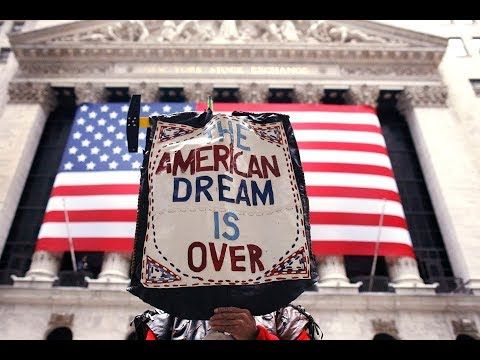This is part two of an ongoing series this week from JB Shreve and the End of History. Check back tomorrow for part three.
In the first part of this series we looked at the dilemma that exists for those living in poverty within the American economic system. They are effectively trapped in poverty. The modern American economy does not offer enough probable incentive to sacrifice the government benefits which must be forfeited if one is to pursue a higher income and standard of living. Included within this trap are a host of social and environmental dangers that solidify the poverty classification for generations on these individuals and their families. Higher crime rates, lower quality healthcare, lower educational standards, and fewer employment opportunities perpetuate the environments where poverty is most rampant. These indirect factors within the culture of poverty enhance the dilemmas and dangers of those living in this economic reality.

As bad as this is for those living in poverty however, the one advantage they have is an ever-present level of attention and focus in the political lens of the American system. Everyone wants to help the poor. The ideas regarding how this help is achieved are not all equal and frequently do as much harm as good but anyone seeking to make a name for themselves in the public sector should seek to help the poor.

The more disenfranchised group within the modern American economy is the middle class. They too are featured in almost every political candidate’s platform but who they are is less specific. This gives politicians the unique opportunity of proclaiming loud and definite solutions and promises for a very vague and obscure group of people. Depending upon where you live and whose measurements you are using being middle class can mean anything from a household income of $25,000 to $144,000. Some studies put $250,000 as the upper limit of a middle class home income.
Increasingly however middle class can be defined less by what a household earns and more by what it does not have access to. Middle class is sitting in the sweet spot for access to the promise to the American dream. Their homes and children are not bound by government restraints. Hard work and responsible decisions can lead to good things in the future – theoretically. Increasingly this upward mobility has diminished over the last 30 years.

Consider the status of a middle class family and household. They do not have access to the benefits and entitlements of those in the poverty classification. Their income disqualifies them from these things. Therefore, they pay full price for schooling, groceries, utilities, etc… The tradeoff of course is far more control for the quality and standard of living which they occupy.
The bulk of America’s economic system is tilted toward the middle class because they are such a large population. Every ounce of possible discretionary income within the middle class is targeted by marketing agencies to increase and cultivate their consumerist tendencies. When discretionary income is maxed out, a second wave of marketing barrages awaits – that of easy credit. From credit cards, to home equity lines of credit to reverse mortgages, no demographic in history has been more saturated with debt applications than the modern American middle class.
Those living in poverty have a virtual ceiling over them made of income limits. If they make too much, they lose their government benefits. For the middle class the ceiling is debt management. Too much debt and their access becomes limited to further debt as their credit scores collapse. At the same time however, because all of the middle class has access to this easy money prices have risen, thus spurring a need and demand for more debt.

As a real life example of this paradox, consider a smartphone. This practically required piece of personal technology in the modern world costs around $230 to make. Manufacturing costs make up just $8 of that total. Let’s say you want to purchase the new iPhone. Your purchase price starts at around $999. That’s a massive profit margin for Apple and it seems horribly unreasonable to the consumer – but we buy it.
In the second quarter of 2018 there were 52 million iPhones sold worldwide. But only a few rare individuals paid a full price lump sum for their phones. Most, whose credit score gave them access, purchased their phone through a series of installment payments included within their cell phone contracts with AT&T, Verizon or whichever carrier they like.
Transpose this same logic and method on housing, cars, schooling, and the list goes on. The easy credit has allowed prices to skyrocket, personal debt to explode, and the middle class to live at an incredible standard of comfort and luxury compared to prior generations. The full costs of this standard of living is starting to come due. More and more middle class Americans are far overstretched on their personal debt and the weight of this growing burden is showing.

Then there is the tax burden. The middle class pays a far higher percentage of their income to taxes than does the rich and wealthy. As far as the cut the government takes, most of their debt (mortgage and student loan debt being the exception) is irrelevant. In other words, if you’re taxed at 15% of your income but you’re making debt payments with 70% of your monthly income, unless that debt is your home or your student loan interest, you’re still taxed at 15% of your income. The government is not concerned with the levels of responsible spending a member of the middle class is handling. They are concerned that the taxes get paid.
We now have the elements in place to understand the growing frustration and desperation among those who live within the modern middle class of America. They are pushed from the top down by taxes. They look out upon those who represent their government and often see dysfunction, incompetence, and corruption. But the government still gets its taxes from them! Meanwhile, while that set of events may be as old as nation-states and citizens, the rising prices the middle class is encountering are not. It is not only the price of a cell phone they have to contend with. The price of groceries, fuel, cable television, and college are all rising, demanding more money than the middle class possesses and therefore higher levels of debt.
In between rising prices, growing debt and constant tax burdens we find America’s middle class – going broke and fed up with the situation.
Watch for the next part in this blog series tomorrow where we will look at what it’s like to be poor in the American Caste System.






